Sports
TCU Wins Inaugural Big 12 Beach Volleyball Championship
Story Links FORT WORTH, Texas – Top-seeded TCU defeated No. 2 seed Arizona State 3-2 to claim the inaugural Big 12 Beach Volleyball Championship title. The Horned Frogs finished the 2025 Championship with a combined score of 9-2 through three matches. TCU’s duo of Hailey Hamlett and Maria Gonzalez were named the […]
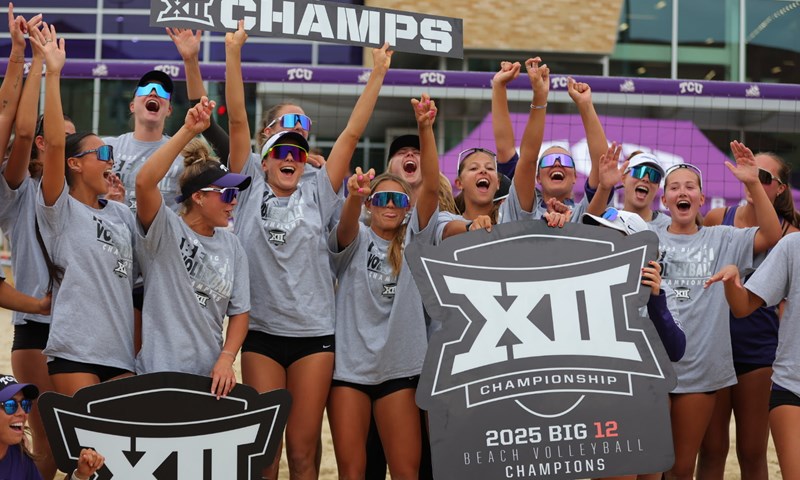
FORT WORTH, Texas – Top-seeded TCU defeated No. 2 seed Arizona State 3-2 to claim the inaugural Big 12 Beach Volleyball Championship title. The Horned Frogs finished the 2025 Championship with a combined score of 9-2 through three matches. TCU’s duo of Hailey Hamlett and Maria Gonzalez were named the Pair of the Tournament after clinching the Conference title. With the score tied at 2-2, the duo finished the win in the third set with a thrilling 21-11, 13-21, 28-26 win on court two.
Arizona State started day two with a 3-1 win over Utah to advance to the Championship final.
The 2025 NCAA Division I Women’s Beach Volleyball Championship selections will be announced on Sunday, April 27 at Noon CT on NCAA.com.
All-Tournament Team
Kylee Fitzsimmons/Brooke Blutreich, ARIZ
Quincy Stephens/Katie McAlister, Utah
Samaya Morin/Ava Kirunchyk, ASU
Arden Besecker/Ava Haughy, ASU
Ana Vergara/Anhelina Khmil, TCU
Hailey Hamlet/Maria Gonzalez, TCU
Match 5
No. 2 Arizona State 3, No. 4 Utah 1
P1: Ava Kirunchyk/Samaya Morin (ASU) def. Quincy Stephens/Katie McAlister (UTAH) 21-16, 21-19
P2: Ava Williamson/Olivia McElroy (ASU) def. Langley Griffin/Bella Vezzani (UTAH) 21-14, 22-20
P3: Daniella Kensinger/Anya Pemberton (ASU) def. Sonja Wessel/Maeve Griffin (UTAH) 21-15, 21-18
P4 : Kylie Pitzak/Ellyn Collins (UTAH) def. Tori Clement/Kendall Whitmarsh (ASU) 21-19, 17-21, 15-13
P5: Arden Besecker/Ava Haughy (ASU) 21-14, 3-3, Lauren Sayre/Elle Burleson (UTAH) unf.
Order of finish: 2, 1, 4, 3
Championship Final
No. 1 TCU 3, No. 2 Arizona State 2
P1: Ava Kirunchyk/Samaya Morin (ASU) def. Daniela Alvarez/Tania Moreno (TCU) 21-18, 21-18
P2: Hailey Hamlett/Maria Gonzalez (TCU) def. Ava Williamson/Olivia McElroy (ASU) 21-11, 13-21, 28-26
P3: Allanis Navas/Sofia Izuzquiza (TCU) def. Daniella Kensinger/Anya Pemberton (ASU) 21-16, 23-21
P4: Ana Vergara/Anhelina Khmil (TCU) def. Tori Clement/Kendall Whitmarsh (ASU) 21-15, 21-11
P5: Arden Besecker/Ava Haughy (ASU) def. Denie Konstantinova/Olivia Clines (TCU) 18-21, 21-19, 15-11
Order of finish: 4, 5, 3, 1, 2
Sports
High bacteria levels prompt closures for these Mass. beaches
Due to high levels of bacteria in these bodies of water, the Massachusetts Department of Public Health (DPH) has closed them for the time being. In total, four beaches are closed, three of which are located in Boston and one in Concord, according to the DPH. The purpose of Concord’s Walden Pond closure is to […]
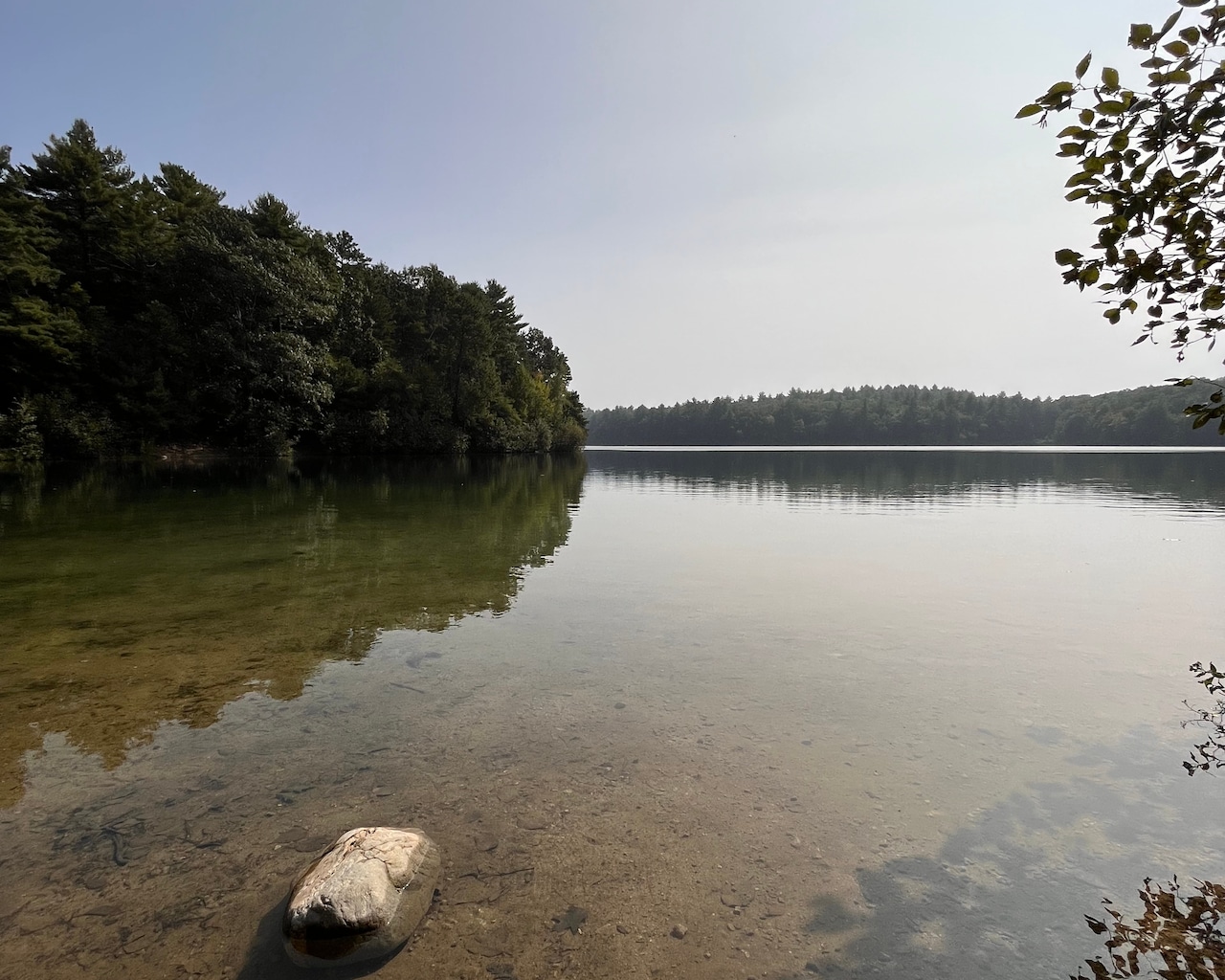
Due to high levels of bacteria in these bodies of water, the Massachusetts Department of Public Health (DPH) has closed them for the time being.
In total, four beaches are closed, three of which are located in Boston and one in Concord, according to the DPH.
The purpose of Concord’s Walden Pond closure is to accommodate facility repair work, according to the DPH, which noted that Red Cross Beach will remain open, weather permitting. Once the project is complete, the beach will reopen.
Constitution, Malibu, and Tenean beaches in Boston, however, are closed with the reasoning being “bacteria excess.”
Bacteria in the water can come from a variety of sources, including:
- Stormwater (rain) run-off
- Failing or malfunctioning septic systems
- Combined and sanitary sewer overflows
- Leaking sewer pipes
- Illegal sewer hookups
- Wildlife and pet waste
- Agricultural runoff
In order to ensure beaches are safe for swimming, the DPH tests the waters anywhere from daily to monthly, depending on how likely the beach is to have water quality issues and its popularity.
If a beach is used often or is prone to water quality issues, then it’s tested more often and vice versa, the DPH wrote.
Beaches remain closed until laboratory analysis shows bacteria levels are within the acceptable range for safe swimming.
“Laboratory analysis for all beach samples takes approximately 24 hours,” according to the department’s website. “So it is common for a beach closure to last a day or two following an exceedance.”
Swimming in beach water that has high levels of bacteria can be risky and can result in illnesses, including:
- Gastrointestinal symptoms- nausea, vomiting, diarrhea and abdominal pain
- Respiratory symptoms- sore throat, cough, runny nose and sneezing
- Dermatological symptoms- skin rash and itching
- Eye and ear symptoms- irritation, earache, itching
- Flu-like symptoms- fever and chills
Therefore, it’s important to check for any warnings or beach closures indicating that the water could be unsafe. To do this, done check the weather, avoid swimming after heavy rain, watch for signs of water pollution like discolored, fast flowing and strong smelling water, do not swim near trash or litter floating in the water, avoid swallowing the water and swim in areas designated as “swim beaches.”
Although a beach could be posted, the public can still visit the location and take part in other activities that don’t involve contact with the water. This can include anything from playing sports like volleyball or frisbee to sunbathing or collecting seashells or sea glass, the DPH said.
The public can also do its part in helping to reduce contamination and pollution at the beach by:
- Cleaning up after pets
- Not feeding the birds as it encourages them to hang around the beaches, which increases fecal matter
- Using public restrooms
- Picking up and throwing away trash using public restrooms or properly disposing of it at home
- Not entering the water when sick or feeling unwell
- Changing diapers and putting plastic or rubber pants, known as swim diapers, on diapered children before they enter the water
- Not dumping anything down storm drains, as water moving through these drains does not get treated at a wastewater facility and flows directly into lakes and streams
- Avoiding the use of fertilizers and pesticides in yards since these chemicals can easily carry into the surface of waters during rain events and snowmelt
- Use walkways and avoid walking on dunes to prevent erosion and preserve vegetation that filters out pollutants from runoff before they reach the beach
More details from the DPH can be found here.
Sports
Eastern Washington Track & Field Wraps Up Season at NCAA West Regional
Story Links COLLEGE STATION, Texas — The Eastern Washington Eagles concluded their track and field season on Saturday, May 31, at the NCAA West Regional. “Definitely a tough meet, but we don’t want anything easy or handed to us,” saif Director of Track and Field / Cross Country Erin Tucker. […]
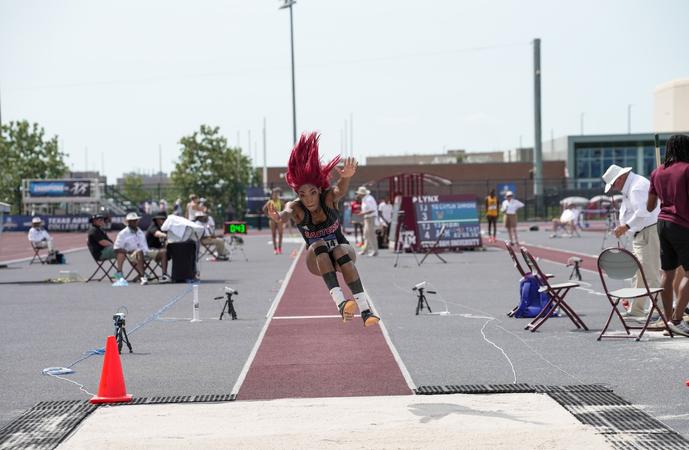
COLLEGE STATION, Texas — The Eastern Washington Eagles concluded their track and field season on Saturday, May 31, at the NCAA West Regional.
“Definitely a tough meet, but we don’t want anything easy or handed to us,” saif Director of Track and Field / Cross Country Erin Tucker.
“We didn’t have the meet we needed, but we learned a lot. I told Maddy and Egypt to do what you did to get here, and you will be fine. What they did to get hear would have moved them on the Eugene.”
On the opening day, Maddy Shekhawat narrowly missed advancing in the 110-meter hurdles. He finished fourth in his heat with a time of 13.96 seconds—just outside the automatic qualifying spots—and placed 33rd overall.
“This is farewell for Egypt in the EWU Uniform, but she has more in the tank for sure. Her story is not over. Maddy will be back here next year and he will not be alone in the sprints. That’s not a promise that is a spoiler!!!!”
Day two featured Egypt Caitlin Simmons in the long jump, where she recorded a mark of 6.19 meters (20 feet, 3.75 inches) to place 24th.
Simmons returned for the triple jump but came up short of the 13.42-meter mark needed to advance. Her best effort of 13.02 meters (42 feet, 8.75 inches) earned her a 26th-place finish.
“Great Year and it is time to get ready for next year! Go Eags!”
Join the Eagle Athletic Fund for as low as $50 per year! Support Eagle student-athletes on and off the field while enjoying exclusive EAF perks such as season ticket and tailgating priority, invitations to special events, exclusive access and more. Visit goeags.com/eaf for more information.
ABOUT EASTERN WASHINGTON UNIVERSITY ATHLETICS
Eastern Washington University Athletics sponsors 14 intercollegiate sports, six for men and eight for women, both as learning opportunities for its most athletically talented students and as an enhancement to student and community life. Eastern is affiliated with Division I of the National Collegiate Athletic Association (NCAA) and is a member of the Big Sky Conference, an association of 10 regional schools with comparable enrollments and academic goals.
FOLLOW THE EAGLES
SOCIAL: Twitter | Facebook | YouTube | Instagram
Sports
Women’s 4×400 Relay Qualifies for Nationals in Dramatic Fashion
Story Links BRYAN-COLLEGE STATION, Texas – A history-making relay wrapped up the Montana State track and field team’s week at the NCAA West First Rounds on Saturday in College Station, Texas. In dramatic fashion, the Bobcat women’s 4×400 meter relay team grabbed the very last ticket to Eugene out of […]
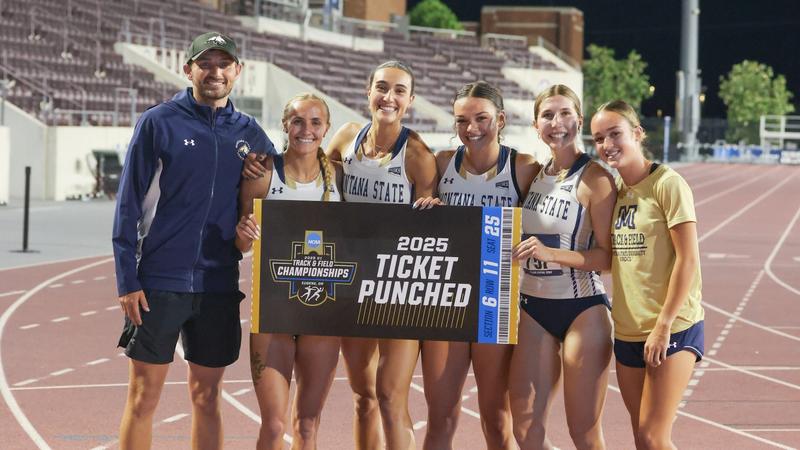
BRYAN-COLLEGE STATION, Texas – A history-making relay wrapped up the Montana State track and field team’s week at the NCAA West First Rounds on Saturday in College Station, Texas.
In dramatic fashion, the Bobcat women’s 4×400 meter relay team grabbed the very last ticket to Eugene out of the final heat of the night, becoming the first-ever relay in school history to qualify for the NCAA Outdoor Track & Field Championships.
Before the joy, however, there were nerves.
Initially, the Cats thought their time of 3:34.31, the second-fastest race in school history, had put them 13th—one spot out of punching one of the 12 tickets to Eugene.
Yet, a team directly ahead of MSU was disqualified and a protest was filed—so the quartet of Olivia Lewis, Peyton Garrison, Giulia Gandolfi, and Caroline Hawkes were stuck in limbo while the big board inside E.B. Cushing Stadium continuously ran the results of the race on a loop.
Finally, after the entire facility had emptied out and what seemed like an eternity of waiting, the results were made official. The Bobcats were headed to Eugene.
It was an incredible effort for a Montana State squad that had been unable to field a relay at the Big Sky Championships due to injury.
Helping save the day on Saturday was Hawkes, a junior from San Clemente, California, who took the baton in seventh place out of eight teams before tearing off an incredible 51.98 second split as the anchor—roaring back to pass three teams and place Montana State fourth in a stacked heat and one spot out of an automatic qualifier but in position to snag the last time qualifier.
The Cats finished ahead of Texas, Oklahoma State, Stanford, BYU, and plenty of other high-pedigree teams to secure their bid and continue a special season.
Lewis, a freshman from Corvallis, started things off before handing the baton to Garrison, a junior from New Castle, Colorado. From there it went to Gandolfi, a junior from Faenza, Italy, and then to Hawkes, the ten-time All-Big Sky honoree.
Thanks to Billings junior Hailey Coey punching her ticket to nationals in the long jump on Thursday, the 4×400 meter relay team’s qualification means the Bobcats will have multiple entries on the women’s side at the NCAA Outdoor Championships for just the fourth time in school history (2015, 2012, 2006).
Those five will join Harvey Cramb (1,500 meters) and Rob McManus (3,000 meter steeplechase) in Eugene from June 11-14, marking four total entries and seven student-athletes who will don the Blue and Gold on the biggest stage in the sport.
Earlier in the day, two Bobcat distance standouts capped memorable tenures with another appearance at the NCAA Regional meet.
In the 3,000 meter steeplechase, Bozeman native Grace Gilbreth closed out a memorable career finishing 31st with a time of 10:27.89.
The school record-holder ends her time in the Blue and Gold with two All-Big Sky honors in cross country and a pair of bronze medals in the steeplechase at the Big Sky Championships.
In the 5,000 meters, graduate student Kyla Christopher-Moody closed out her career placing 38th with a time of 16:41.73.
Christopher-Moody, a native of Royal Oak, Michigan, set four school records this year in the indoor mile, indoor 3,000 meters, outdoor 1,500 meters, and outdoor 5,000 meters.
UP NEXT
Seven Montana State track and field athletes advance to compete at the 2025 NCAA Outdoor Track & Field Championships, held June 11-14 at Historic Hayward Field in Eugene, Oregon.
Hailey Coey (long jump), Harvey Cramb (1,500 meters),Rob McManus (3,000 meter steeplechase), and the women’s 4×400 meter relay team (Olivia Lewis, Peyton Garrison, Giulia Gandolfi, and Caroline Hawkes) will all represent the Bobcats at the national championship meet, marking the fourth straight year Montana State has sent at least three qualifiers to the NCAA Outdoor Championships.
The four Bobcat entries at the national meet are tied for the third-most in program history, behind only the five in 2023 and 2022. The Cats also qualified four entries to the national meet in 2015.
The 2025 NCAA Outdoor Track & Field Championships will air on the ESPN family of networks.
#GoCatsGo
Sports
How an oddball smuggled out the KGB’s biggest secrets
In March 1992 a scruffily dressed, unshaven old man knocked on the door of the newly opened British embassy in Vilnius, Lithuania. He was carrying what might have been a bag of laundry. From it he produced some pieces of paper on which were scribbled handwritten notes. The man said he wanted to speak to […]
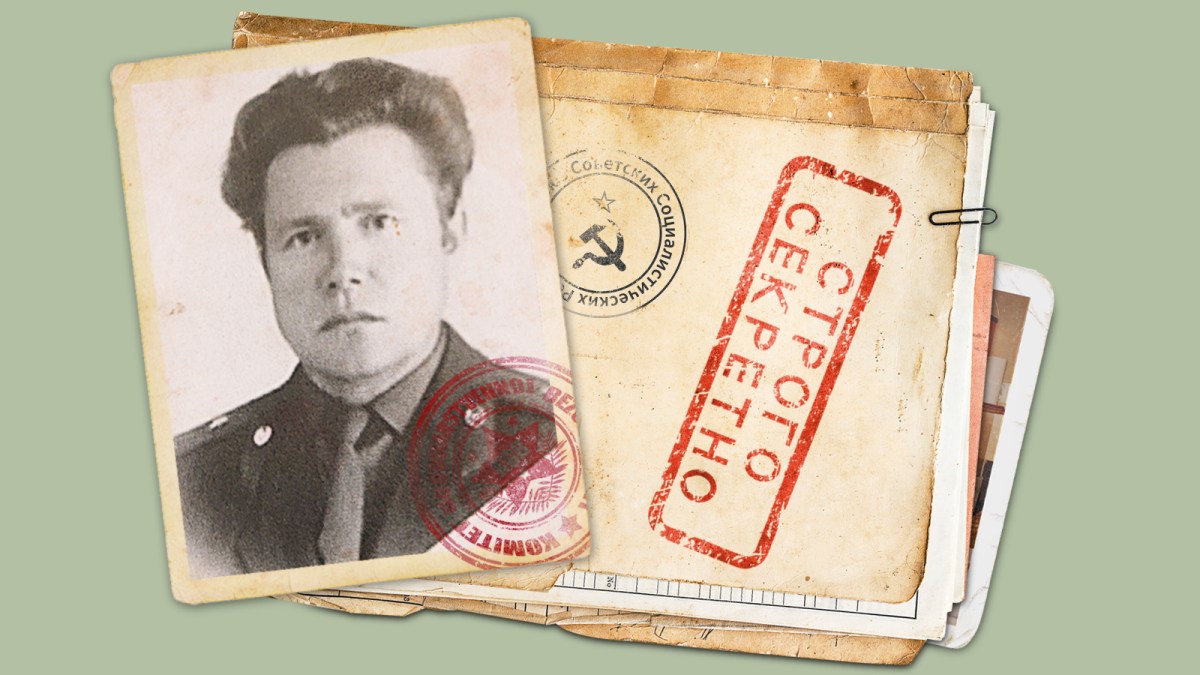
In March 1992 a scruffily dressed, unshaven old man knocked on the door of the newly opened British embassy in Vilnius, Lithuania. He was carrying what might have been a bag of laundry. From it he produced some pieces of paper on which were scribbled handwritten notes.
The man said he wanted to speak to somebody. Already the Americans had taken one look at him and sent him back into the cold. Luckily a junior female British diplomat had better instincts, for what Vasili Mitrokhin was touting was what the CIA would call “the biggest counterintelligence bonanza of the postwar period”.
His duffle bag contained many of the most important secrets in the KGB’s archive, where he had worked for three decades. The surreptitiously copied documents Mitrokhin would ultimately pass on to MI6 offered, its chief, Sir Richard Dearlove, said, “a sweeping overview of KGB operations over 50 years”.
Among the treasure dropped into the West’s lap were lists of names of numerous KGB agents abroad, both “illegals” — long-term penetration spies operating under false identities — as well as contacts passing on information. Shockingly, there proved to be 300 of the latter in the French establishment, and 30 in the Italian foreign ministry alone. In Britain Mitrokhin’s revelations led to the public unmasking of the last of the atom programme spies, Melita Norwood, dubbed by The Times, because of her shopping habits, “The spy who came in from the Co-op”.
Significant though this haul was, as tales of espionage go, one largely set amid the piled-up files of a vast bureaucracy is not an obvious page-turner. Moreover, the introverted Mitrokhin never offered much insight into the motivation for his actions and many of the details of his defection remain secret. Nevertheless, this is a wilderness that Gordon Corera, formerly the BBC’s security correspondent and now co-presenter with the spy novelist David McCloskey of the intelligence podcast The Rest Is Classified, is well equipped to traverse.
Whatever one makes of Mitrokhin — and his MI6 handlers thought him a prickly oddball — it certainly took remarkable courage to do what he did. Years of reading the files he was storing turned Mitrokhin from a true believer in communism into a quietly ardent opponent of its repressive machinery. When the KGB began moving its headquarters from the Lubyanka in Moscow to a new site in the 1970s — a huge operation as the organisation was generating three million documents a year — Mitrokhin was tasked with selecting which files should go and which should stay.
Some inconvenient ones had already been destroyed, for instance files that may have revealed the young Stalin was in touch with the tsar’s secret police. Determined to expose the system to the light, Mitrokhin started to make aides-memoire of what he read — tiny scraps of paper in code that he smuggled out of the archive hidden in his socks.
The KGB informant Melita Norwood was dubbed ‘The spy who came in from the Co-op’
TONY HARRIS/PA
Aided by a photographic memory, even for passport numbers and addresses, at weekends he would go to his country cottage, or dacha, and reconstitute the documents with a typewriter. This he christened Erika, and he thought of it as “the love of his life”.
• Meet ‘the illegals’ — Russia’s spies next door
All too aware of the resources and paranoia of the KGB, he took pains not to be seen to be buying equipment for Erika, instead making ink from fruit juice and fabricating new ribbons from scraps of old ones. For 12 years, until his retirement in 1984, Mitrokhin typed, burying what became the volumes he had compiled — one exposed the hidden scale of the Soviet Union’s losses in Afghanistan — in milk churns concealed under the dacha.
Had he been caught, the best he could have expected was a bullet in the back of the head. Given the necessarily slow pace of Mitrokhin’s work, however, Corera sensibly tries to broaden the story by setting it within the wider context of the Soviet Union’s history. That in turn offers some insights into Mitrokhin’s motivation.
• How Russia used Brazil as breeding ground for spies
“Defectors defect because they are defective,” runs an old spying trope. In Mitrokhin’s case he seems to have become disillusioned after being reprimanded when a field operative in Israel. Then, in 1956, while in Melbourne keeping an eye on the Soviet Union’s Olympic team, he found himself less than covertly in the sights of the press. He was photographed publicly urging the water polo team to hit back at their Hungarian opponents, who had vented their fury at the crushing of the uprising in Budapest then taking place.
A picture of a Hungarian player with blood running down his face went around the world, and the embarrassment led to Mitrokhin being sent to KGB’s equivalent of the salt mines: its archive.
The bloodied Hungarian water polo player Ervin Zador at the 1956 Olympics
BETTMANN ARCHIVE
What Corera conveys particularly well is Mitrokhin’s peculiarly Russian mindset. Mitrokhin could loathe the unfairness that underpinned how the KGB operated while staying a Russian nationalist, convinced of its moral superiority over the West. He especially deplored the KGB’s targeting of intellectuals, the guardians of Russia’s culture. The KGB was always hottest on defectors of this kind. Mitrokhin saw files revealing plots to break Rudolf Nureyev’s legs when he went to America, while 18 officers were dispatched to the Philippines to ensure that a chess player beat a formerly Russian
opponent.
Mitrokhin’s chance came with the end of the Soviet Union in 1991, the seismic event that seemed to end the career of a young KGB officer, Vladimir Putin. Corera has unearthed new details of his exfiltration. This was much more complex than that of, say, the KGB defector Oleg Gordievsky, as Mitrokhin wanted to bring not just his archive but his whole family, including his aged mother-in-law, none of whom had been told what was happening.
The operation was authentically chaotic rather than executed with Bond-like panache. Emergency numbers didn’t work, minibuses had to be commandeered in the street, and the wheelchair of Mitrokhin’s son — who suffered from a neurological illness — was too wide for the gangplank of the ship on which the family were meant to escape. Yet so low-key had Mitrokhin been all his life that no one noticed he had gone.
“Mitrokhin is a really difficult person,” observed Christopher Andrew, the Cambridge don who worked with him on publishing the archive commercially in 1999. “But he is also a hero.”
The book’s author Gordon Corera co-hosts the intelligence podcast The Rest Is Classified
The weird thing was that no one knew quite how to handle the weapon the West had been given. The Treasury jibbed at the cost of resettling Mitrokhin’s family, the politicians regarded information about a seemingly vanquished enemy’s historic operations as old hat, while the spooks would sometimes rather not have been reminded of their failure to catch moles.
Mitrokhin’s hope had been that his exposure of the KGB’s crackdown on domestic dissent would lead to Nuremberg-style justice for Russia’s former leaders. The West, however, focused more on what he revealed about the Soviet Union’s penetration of its bureaucracies and economies.
• Read more book reviews and interviews — and see what’s top of the Sunday Times Bestsellers List
In the years before he died, in 2004 at the age of 81, Mitrokhin became disappointed with what he found in the West, and nostalgic for the somewhat idealised, Tolstoyan version of the deep Russia he had left behind. Corera perhaps labours the point that it is a mentality shared with Putin and his supporters, yet The Spy in the Archive is nevertheless the overdue and often striking memorial Mitrokhin merits.
The Spy in the Archive: How One Man Tried to Kill the KGB by Gordon Corera (William Collins £25 pp336). To order a copy go to timesbookshop.co.uk. Free UK standard P&P on orders over £25. Special discount available for Times+ members
Sports
No. 11 Women’s Track and Field advances six events to NCAA Outdoor Championships
Story Links COLLEGE STATION, Texas – No. 11 Texas Women’s Track and Field finished the last day of the NCAA West First Round and advanced six events to the NCAA Outdoor Championships. The women’s 4×100-meter relay showed off a new lineup with Carleta Bernard, Holly Okuku, Kenondra Davis and Ramiah Elliott and […]

COLLEGE STATION, Texas – No. 11 Texas Women’s Track and Field finished the last day of the NCAA West First Round and advanced six events to the NCAA Outdoor Championships.
The women’s 4×100-meter relay showed off a new lineup with Carleta Bernard, Holly Okuku, Kenondra Davis and Ramiah Elliott and recorded a season-best time of 42.85 to advance to Eugene.
Sophomore Akala Garrett advanced in both hurdle events for the first time in her career after recording a personal-best non-winded time of 12.98 in the 100-meter hurdles. She later set the E.B. Cushing Stadium record in the 400-meter hurdles with a time of 54.72, the sixth-fastest time in UT history. Garrett will be the first Longhorn to compete at the NCAA Championships in both hurdle events in the same season since Rasin McIntosh competed in both events in 2003 and 2004.
Freshman Mackenzie Collins also reached the NCAA’s in the 400m hurdles, earning the last spot with a time of 57.14. It marks the second-straight season the Longhorns have sent a freshman to the NCAA Championships in the event after Garrett went last season.
Texas later sent two through in the 200-meter dash. Kenondra Davis equaled her personal best with a time of 22.58, moving her up to No. 10 on the school’s all-time performer list. Okuku qualified for her first individual NCAA event by matching her personal best with a time of 22.85, the 10th-fastest time of the night.
Results
Akala Garrett – 1st – 400mH – 54.72 (qualified)
Bernard, Okuku, Davis, Elliott – 2nd – 4×100 – 42.85 (qualified)
Akala Garrett – 5th – 100mH – 12.98 (qualified)
Kenondra Davis – 6th – 200m – 22.58 (qualified)
Holly Okuku – 10th – 200m – 22.85 (qualified)
Mackenzie Collins – 12th – 400mH – 57.14 (qualified)
Chrystal Herpin – 13th – Discus – 53.89m
Collins, Elliott, Bernard, Koom-Dadzie – 4×400 – 3:35.12
Elizabeth Stockan – 24th – 1500m – 4:34.62
Elizabeth Pickett – 33rd – 5000m – 16:36.68
Sports
Mosley Wraps Up CSUN’s Stay at the NCAA West First Round
Story Links COLLEGE STATION, Texas—CSUN Track & Field’s Summer Mosley concluded her stay at the NCAA West First Round on Saturday at E.B. Cushing Stadium by competing in the discus. Mosley would register her longest throw on her third and final attempt, which went for 50.09m (164-4). That throw would place her […]
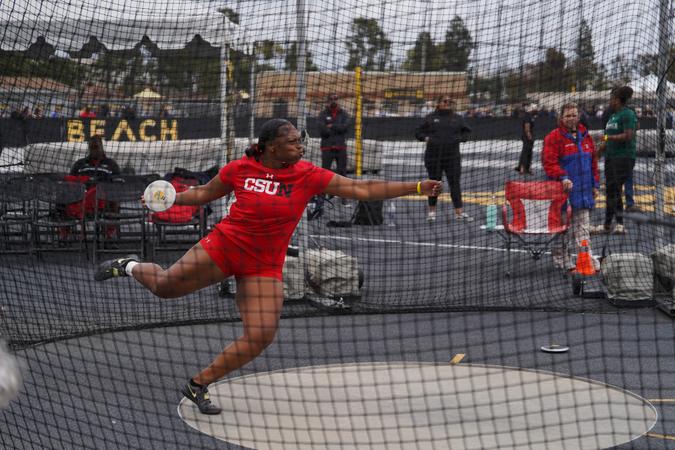
COLLEGE STATION, Texas—CSUN Track & Field’s Summer Mosley concluded her stay at the NCAA West First Round on Saturday at E.B. Cushing Stadium by competing in the discus.
Mosley would register her longest throw on her third and final attempt, which went for 50.09m (164-4). That throw would place her 38th overall out of a 48-athlete field, but short of advancing to the NCAA Outdoor Championships. Mosley also competed in the hammer throw this past Thursday at the regional, finishing 25th overall with a toss of 57.92m (190-0).
A native of Miami, Mosley had a career season in her first year with CSUN. Mosley would win two individual titles at the 2025 Big West Championships, finishing first in the hammer throw at 59.66m (195-9) and the discus at 53.51m (175-7). The two title wins were her first conference titles in her collegiate career.
Overall, CSUN was represented in nine different events at this year’s NCAA West First Round with six on the men’s team and three on the women’s team. The three regional appearances from the women were the most since the 2019 season. In all, CSUN broke three men’s records this outdoor season while 13 all-time top-10 marks were set across the men’s and women’s teams.
ACCORDING TO COACH JUSTIN JOHNSON
“I’m proud of our performances this week, even though things didn’t fall our way, I know that each student-athlete put their all into their performances. And for that, I am thankful and proud of each and every one of them. From the outside looking in, some may see this as a failure, but we are all on a journey seeking greatness and sometimes you will fall. There are great lessons to learned in defeat. I believe these young men and women have what it takes to pick each other up and continue on our journey in search of greatness. We will be back next year physically, mentally and emotionally stronger because of the experiences we have gone through and our willingness to do what it takes to be great. Go Matadors!”
#GoMatadors
-

 College Sports2 weeks ago
College Sports2 weeks agoPortal Update – Basketball and Gymnastics Take Hits
-

 Rec Sports2 weeks ago
Rec Sports2 weeks agoThe Program, a New Basketball Training Facility, Opening in Greenpoint This September
-

 College Sports2 weeks ago
College Sports2 weeks agoPortal Update – Basketball and Gymnastics Take Hits
-

 Youtube3 weeks ago
Youtube3 weeks agoKYRIE Irving can’t miss!
-

 Motorsports3 weeks ago
Motorsports3 weeks agoNASCAR Cup Series Point Standings After Kansas
-

 Youtube3 weeks ago
Youtube3 weeks agoThe Caitlin Clark Impact
-

 Professional Sports1 week ago
Professional Sports1 week agoJon Jones answers UFC retirement speculation as fans accuse champion of 'holding the belt …
-

 Youtube3 weeks ago
Youtube3 weeks agoSGA Iso Moments That Will Make You Say WOW
| 2024-25 NBA Season
-

 Youtube3 weeks ago
Youtube3 weeks agoJalen Brunson & Josh Hart on Knicks’ confidence in back-to-back 20-PT comeback wins
| NBA on ESPN
-

 Youtube3 weeks ago
Youtube3 weeks agoCanon’s reaction to the Warriors’ loss
(via @nbcsportsauthentic/TT)







































